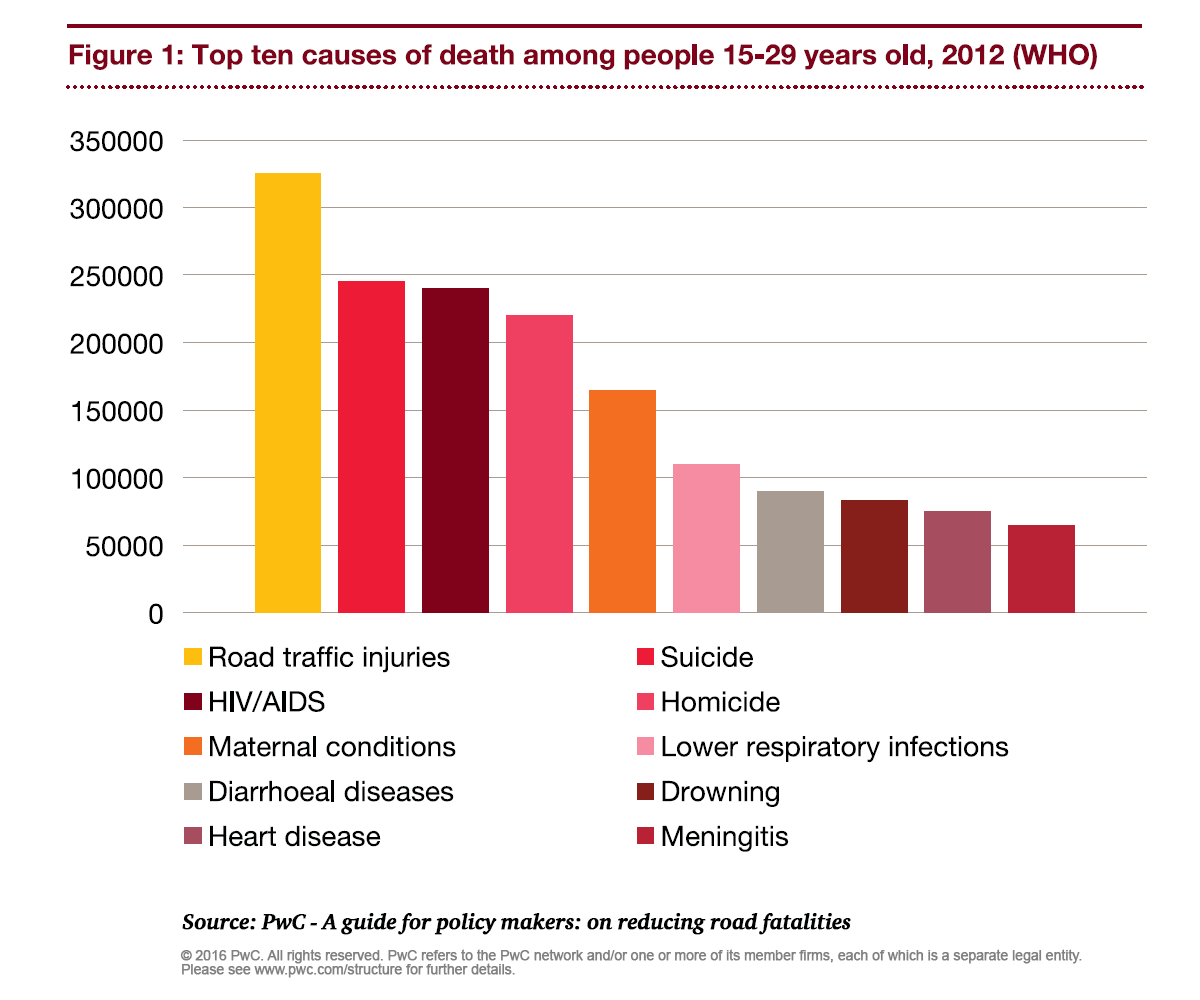A Guide for Policy Makers: On Reducing Road Fatalities
Every day, road traffic accidents claim more than 3,400 lives worldwide, with a total of 1.25 million deaths annually. The highest majority of victims are young people aged between 15 and 29 years old living in low-income countries.
This report intends to support governments and policy makers in reducing road traffic fatalities by providing the necessary tools that help in the development of a successful road safety strategy. Moreover, this report has been informed by a review of successfully implemented strategies globally and by evidence-based reports, to serve as a baseline for governments at a national, regional or local level to tailor their own strategic plans and answer their unique challenges.

Our view: Characteristics of a Good Strategy
A Holistic Strategy that addresses all of the risk factors associated with road traffic fatalities
Good Data management and analytical arrangements that ensure a full understanding of the causes and circumstances of road traffic fatalities
Effective and Inclusive Partnerships with a shared objective to reduce road traffic fatalities with a clear plan and accountability
Situation at a glance
Over 1.2 million people die each year on the world’s roads, with millions more sustaining serious injuries and living with long-term adverse health consequences.
Road collisions incur huge economic costs at a national level, which includes a burden on the health, insurance and legal systems. Moreover, they can have negative social implications for the families of those involved as well as on local communities.



Top 5 risk factors for Traffic Collisions Worldwide
Speeding
An adult pedestrian’s risk of dying is less than 20% if struck by a car at 50 km/h and almost 60% if struck at 80 km/h
Drink-Driving
Checkpoints and random breath testing can lead to reductions in alcohol-related crashes by 20% and have shown to be very cost-effective
Distracted Driving
Drivers using a mobile phone are 4 times more likely to be involved in a crash
Seatbelts & Child Restraints
Seatbelts reduce the risk of road fatalities among front-seat passengers by 40-50% and of rearseat passengers by between 25-75%
Motorcycle Helmets
Wearing a motorcycle helmet correctly can reduce the risk of death by almost 40% and the risk of severe injury by over 70%
Source: World Health Organisation
What works in reducing Road Traffic Fatalities
Leading Practice suggests that successful strategies should focus on six main themes
National Programmes and Target Setting
- Partnership model for road safety programmes
- Reduction in the absolute number of road fatalities
Safer Driving Behaviour
- Seat belt enforcement
- Speeding enforcement
- Intoxicated driving intervention
Safer Vehicles and Roads
- Road engineering enhancement
- Vehicle safety enhancement
Safer Pedestrians and other Vulnerable Road Users
- Pedestrian infrastructure
- Increasing visibility
- Reducing vehicle speeds
Education, Training, and Publicity (ETP)
- Risk awareness, personal safety and safety of others
- Graduated licensing system
Data systems
- Reliable database to inform policy-making
The prerequisites of a successful Road Safety Strategy
A comprehensive strategy encompasses the safety approaches and systems that contribute to Road Safety as well as the agencies that have a role in contributing to the delivery of the strategy.
Our suggested model for a successful road safety strategy is based on good quality data, the 3 E’s and the Safer System Approach. However, the pillar of this model is a matrix of effective partnerships.
1. Basing your Strategy on Good Data
Any effective strategy needs to be built on reliable data. This ensures that activities are targeted at those factors most contributing to road traffic fatalities. All high performing countries have good quality data systems (with high accuracy and integrity) on which to base policies, regulations, and initiatives. The Safety Net project, a study undertaken by a consortium of key European Road Safety Research Institutes on behalf of the European Commission, found that data should be collected using a consistent, transparent and independent framework with no interference from stakeholders. It is also crucial to train investigators on how to investigate traffic collisions and accurately collect reliable data.
2. Engineering for a Safer System
Effective engineering plans take into consideration both infrastructure and technology. A well designed infrastructure reduces road hazards and promotes the safety of road users. Moreover, vehicle and infrastructure related technologies increase road and vehicle safety while reducing fatal accidents.
3. Education for Safer People
Evidence based studies have shown that education is crucial to developing safer people and safer communities; therefore, road safety must be taught in schools as well as through driver trainings and safety campaigns.
4. Enforcing Road Safety Laws
Effective enforcement includes written laws and sanctioned schemes that are well thought out and contextualised, but still based on proven leading practice. Enforcement also includes physical enforcement mechanisms both through police and technology (e.g. radars, cameras, etc.). Enforcement is critical in putting education and engineering efforts into effect, in
order to achieve a complete Safer System.
5. Delivering through Partnerships
Partnerships that include a range of expertise relating to the human, vehicle, environment and legal aspects of road accidents, are an extremely positive asset to a road safety strategy. Those partnerships involve a collaboration between different organisations that can leverage a diverse range of skills and work together towards the common goal of casualty reduction. Partnerships are effectively the back-bone for successful road safety achievements.
6.Conclusion: Achieving a Safer System
PwC’s proposed strategy framework is comprehensive and is based on a thorough analysis of leading practices and evidence-based studies. The designed strategy allows for global contextualization and equips policymakers with enough tools to assess their current road safety strategy and address their country-specific needs. In addition, it comprises all the essential components required for a successful road safety strategy: data, engineering, education, enforcement and partnership. By combining those 5 elements, policymakers will have also covered all aspects of the Safer System Approach.

How PwC can help
PwC has acquired extensive experience in assisting governments in meeting their targets around reducing the number of road traffic fatalities nation-wide. With the help of our global network of Subject Matter Experts, we have been successful in developing road safety strategies, organizational transformation and operational implementation both globally and in the Middle East. In addition, our operational experience has been complemented with our relationship with Loughborough University which adds academic rigour by identifying and contextualising the most effective road safety practices worldwide. Hence, this combination best positions us to provide innovative, practical and impactful solutions tailored to our clients’ needs to address global issues.
Our approach focuses on four different stages

Reviewing Current Arrangements
Reviewing and measuring the current arrangements in place; Analyzing the internal and external key factors
Leading Practice
Identifying leading practices with inputs from academics at Loughborough university
Gap Analysis
Identifying existing gaps and key challenges
Strategy Development
Developing a road safety strategy tailored to the country’s specific needs and unique culture









